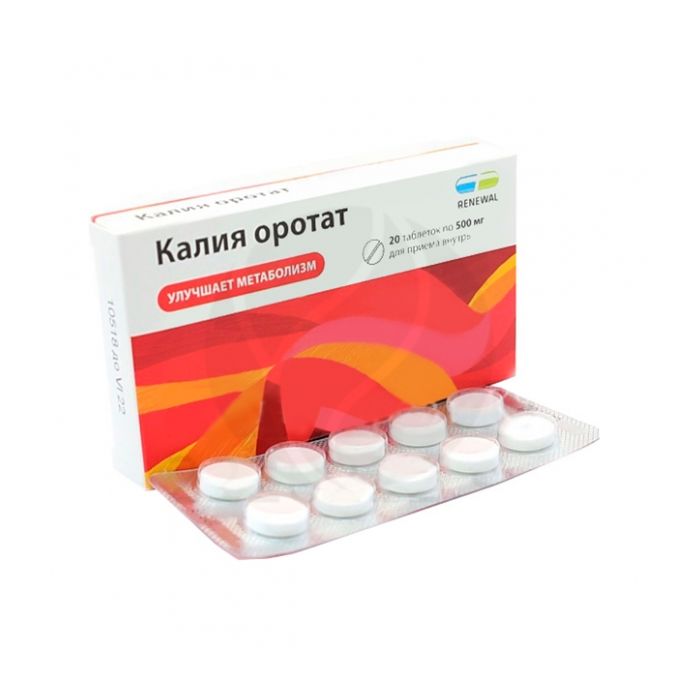Potassium orotate tablets 500mg, No. 20
Expiration Date: 05/2027
Russian Pharmacy name:
Калия оротат таблетки 500мг, №20
As an adjuvant in diseases of the liver and biliary tract (caused by acute and chronic intoxication, with the exception of organic lesions of the liver and biliary tract);
as part of a combination therapy for chronic heart failure and heart rhythm disturbances;
alimentary and alimentary-infectious malnutrition in children;
chronic physical stress.
Should be taken orally 1 hour before meals or 4 hours after meals.
Adults 250-500 mg 2-3 times a day. The course of treatment lasts 20-30 days.
On the recommendation of a doctor, it is possible to repeat the course of treatment in a month.
In exceptional cases, you can increase the dose of adults up to 3 g per day.
Children - 10-20 mg / kg of body weight per day. The course of treatment is 3-5 weeks.
If symptoms persist, consult your doctor.
1 tablet contains:
Active ingredient: potassium orotate - 500.0 mg;
Excipients: lactose monohydrate - 66.0 mg; medical gelatin - 3.0 mg; stearic acid - 7.4 mg; potato starch to obtain a tablet weighing 750.0 mg.
Hypersensitivity to any component of the drug;
acute and chronic organic liver damage;
ascites;
nephrourolithiasis;
renal failure;
lactose intolerance;
lactase deficiency;
glucose-galactose malabsorption;
children's age up to 3 years.
Trade name of the drug:
Potassium orotate
International non-proprietary or group name:
Orotic acid
Dosage form:
pills
Composition:
1 tablet contains:
Active ingredient: potassium orotate - 500.0 mg;
Excipients: lactose monohydrate - 66.0 mg; medical gelatin - 3.0 mg; stearic acid - 7.4 mg; potato starch to obtain a tablet weighing 750.0 mg.
Description:
Round, flat-cylindrical tablets of white color with a bevel on both sides of the tablet and a score on one side.
Pharmacotherapeutic group:
metabolic agent.
ATX code:
A05BA
Pharmacological properties
Pharmacodynamics
Orotic acid is one of the precursors of pyrimidine nucleotides that are part of nucleic acids, which are involved in the synthesis of protein molecules, and therefore, salts of orotic acid are considered as substances of anabolic action and are used for disorders of protein metabolism, for their stimulation. The potassium salt of orotic acid (potassium orotate) is usually used. Potassium orotate stimulates the synthesis of nucleic acids, the production of albumin in the liver (especially under conditions of prolonged hypoxia), increases appetite, has diuretic, regenerating properties.
Pharmacokinetics
After oral administration, 10% of the oral dose is absorbed in the gastrointestinal tract. In the liver, it is converted into orotidine-5-phosphate. It is excreted by the kidneys (30% as metabolites).
Indications for use
As an adjuvant in diseases of the liver and biliary tract (caused by acute and chronic intoxication, with the exception of organic lesions of the liver and biliary tract);
as part of a combination therapy for chronic heart failure and heart rhythm disturbances;
alimentary and alimentary-infectious malnutrition in children;
chronic physical stress.
Contraindications
Hypersensitivity to any component of the drug;
acute and chronic organic liver damage;
ascites;
nephrourolithiasis;
renal failure;
lactose intolerance;
lactase deficiency;
glucose-galactose malabsorption;
children's age up to 3 years.
Method of administration and dosage
Should be taken orally 1 hour before meals or 4 hours after meals.
Adults 250-500 mg 2-3 times a day. The course of treatment lasts 20-30 days.
On the recommendation of a doctor, it is possible to repeat the course of treatment in a month.
In exceptional cases, you can increase the dose of adults up to 3 g per day.
Children - 10-20 mg / kg of body weight per day. The course of treatment is 3-5 weeks.
If symptoms persist, consult your doctor.
Overdose
Overdose data are not available.
Side effect
Allergic skin reactions may occur, which disappear after interruption of treatment. Potassium orotate can also cause mild indigestion (nausea, vomiting). When used in high doses against the background of a low-protein diet, the development of liver dystrophy is possible.
If you experience side effects, consult your doctor.
Interaction with other medicinal products
Potassium orotate slightly reduces the toxicity of cardiac glycosides; the effect is increased when combined with magnesium preparations. Astringents and coating agents may slightly reduce the absorption of potassium orotate in the gastrointestinal tract. Potassium orotate complicates the absorption of iron, tetracycline, sodium fluoride (the interval between taking the drug is at least 2-3 hours). Oral contraceptives, diuretics, muscle relaxants, glucocorticosteroids, insulin reduce the effect of the drug.
Use during pregnancy and breastfeeding
It must be used with caution during pregnancy and breastfeeding.
special instructions
During the treatment period, it is desirable to follow the diet (stop No. 5).
Influence on the ability to drive vehicles and work with mechanisms
Does not cause drowsiness and a decrease in the speed of psychomotor reactions.
Release form
500 mg tablets.
On 10 tablets in a blister strip packaging from a film of polyvinyl chloride and printed aluminum foil varnished.
1, 2, 3, 4, 5 blister packs, together with instructions for use, are placed in a cardboard box.
100, 200, 300, 400, 600, 800 blisters with an equal number of instructions for medical use are placed in a cardboard box (For hospitals).
Storage conditions
In a dark place at a temperature not exceeding 25 ? C.
Keep out of the reach of children.
Shelf life
4 years.
Do not use the drug after the expiry date indicated on the package.
Vacation conditions
Available without a prescription.

